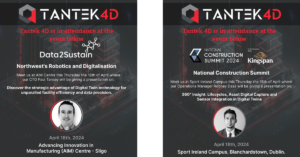If you are a senior leader in the construction industry, building management, or facilities management, your data culture could be holding you back.
If you are responsible for a building or facility’s CapEx and/or OpEx budget, the data culture in your organisation could be wasting your limited resources.
A poor data culture in construction and facilities management also increases health and safety risks, makes it more difficult to achieve sustainability goals, and leads to mistakes, double work, and low productivity due to ineffective collaboration.
The solution is straightforward. We’ll get to it in more detail later in the blog, but the core element is to take a long-term, holistic approach to data. By taking a long-term, holistic approach to data, projects will run more smoothly, you’ll achieve more from your budgets, and you will see a positive impact on a variety of KPIs, from H&S to sustainability to productivity.
Data Is Nothing New
The main focus of this blog is the concept of data culture and what it looks like in your organisation. That term, “data culture”, is a bit of tech industry jargon that we’ll come back to shortly. For now, we’ll focus on data, as data is essential in construction and facilities management, and has been forever thus.
The fact is data has always played a crucial and often indispensable role in building and facilities management.
Drawings are data. Specification documents are data. Standard operating procedures are data. Plus, HVAC systems, alarms, CCTV systems, access control systems, electricity meters, and more all produce and use data.
In construction and facilities management, data is not a futuristic concept. Data is everywhere.
Problems arise with how data is created, communicated, distributed, stored, analysed, and used.
This brings us back to the concept of data culture.
What is a Data Culture?
A data culture refers to the behaviours and attitudes of the people in your organisation in relation to data. A positive data culture is where data is valued, readily accessible, and used by default in decision-making.
In this blog, we are focusing specifically on the construction, building management, and/or facilities management functions of your organisation. In these functions, organisations often come up short:
- Data is valued – data is valued, but on a short-term, project-by-project basis.
- Data is readily accessible – data is sometimes readily accessible and when it is not, services are procured to produce the data that is required (via a laser scanning survey, for example). However, the short-term, project-by-project approach often remains prevalent, i.e., I need data for project “A” so I will go and get that data without much thought to projects “B”, “C”, “D”, etc which will need similar data in future months and years.
- Data is used by default in decision-making – most organisations will strive for this wherever possible, but the realities of construction and facilities management mean the data being used to make decisions is often incomplete and/or inaccurate.
Creating the Right Data Culture in Your Organisation
Earlier in this blog, we mentioned the solution to creating the right data culture in your organisation and, more specifically, for your construction and facilities management functions. What does this mean in practice?
It means moving away from a siloed way of working where project teams start with a blank or close-to-blank slate. It means investing in data today to deliver benefits not just for your immediate projects, but your projects in the future, both planned and those you are yet to foresee. And it means adopting a more centralised, joined-up approach to data to facilitate knowledge sharing and collaboration.
Getting down to a practical level, an effective approach is to create a 3D, interactive, and dynamic as-is digital representation of your facility. At Tantek 4D, we call this Asset Reality Capture, and it represents a small investment when you consider it produces a 3D digital representation (or digital twin) that can be used across multiple projects, business functions, and initiatives.
Moving Forward
Creating a digital twin of your facility will represent a significant step forward in your organisation’s data culture, enabling data-driven decision-making and reducing costs, while also improving productivity, project management processes, and essential KPIs.
The summary is that data is already crucial for your role and the performance of your team. Establishing the right data culture and adopting technologies like digital twins will modernise your operations and take them to the next level.




